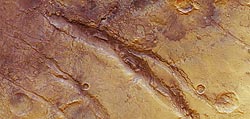Mars Express sees deep fractures on Mars

Deep fractures on Mars
Nili Fossae is a ‘graben’ system on Mars, northeast of the Syrtis Major volcanic province, on the northwestern edge of the giant Isidis impact basin. Graben refers to the lowered terrain between two parallel faults or fractures in the rocks that collapses when tectonic forces pull the area apart. The Nili Fossae system contains numerous graben concentrically oriented around the edges of the basin.
It is thought that flooding of the basin with basaltic lava after the impact that created it resulted in subsidence of the basin floor, adding stress to the planet’s crust, which was released by the formation of the fractures.
A strongly eroded impact crater is visible to the bottom right of the image. It measures about 12 km across and exhibits an ejecta blanket, usually formed by material thrown out during the impact. Two landslides have taken place to the west of the crater. Whether they were a direct result of the impact or occurred later is unknown.
A smaller crater, measuring only 3.5 km across, can be seen to the left of centre in the image and this one does not exhibit any ejecta blanket material. It has either been eroded or may have been buried.
The surface material to the top left of the image is much darker than the rest of the area. It is most likely formed of basaltic rock or volcanic ash originating from the Syrtis Major region. Such lava blankets form when large amounts of low-viscosity basaltic magma flow across long distances before cooling and solidifying. On Earth, the same phenomenon can be seen in the Deccan Traps in India.
Nili Fossae interests planetary scientists because observations taken with telescopes on the Earth and published in 2009 have shown that there is a significant enhancement in Mars’ atmospheric methane over this area, suggesting that methane may be being produced there. Its origin remains mysterious, however, and could be geological or perhaps even biological.
As a result, understanding the origin of methane on Mars is high on the priority list and in 2016, ESA and NASA plan to launch the ExoMars Trace Gas Orbiter to investigate further. Nili Fossae will be observed with great interest.
Media Contact
All latest news from the category: Physics and Astronomy
This area deals with the fundamental laws and building blocks of nature and how they interact, the properties and the behavior of matter, and research into space and time and their structures.
innovations-report provides in-depth reports and articles on subjects such as astrophysics, laser technologies, nuclear, quantum, particle and solid-state physics, nanotechnologies, planetary research and findings (Mars, Venus) and developments related to the Hubble Telescope.
Newest articles

Properties of new materials for microchips
… can now be measured well. Reseachers of Delft University of Technology demonstrated measuring performance properties of ultrathin silicon membranes. Making ever smaller and more powerful chips requires new ultrathin…

Floating solar’s potential
… to support sustainable development by addressing climate, water, and energy goals holistically. A new study published this week in Nature Energy raises the potential for floating solar photovoltaics (FPV)…

Skyrmions move at record speeds
… a step towards the computing of the future. An international research team led by scientists from the CNRS1 has discovered that the magnetic nanobubbles2 known as skyrmions can be…





















